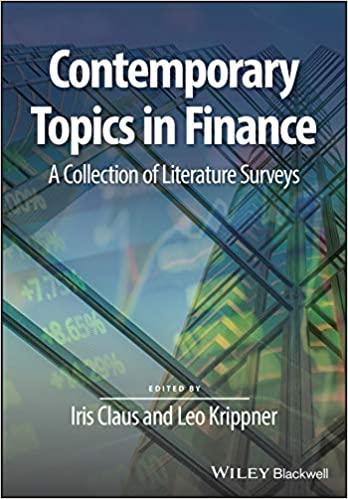Question
2.The money multipliers tend to fall during a financial panic due to a rise in: Question options: the currency deposit ratio. lending. level of money
2.The money multipliers tend to fall during a financial panic due to a rise in:
Question options:
| the currency deposit ratio. | |||
| lending. | |||
| level of money market deposit mutual funds. | |||
| Question 3 | 0 / 1 point | ||
If the Fed buys $100 in securities and the reserve requirement is 10%, according to the simple formula for the money multiplier, the money supply
Question options:
| falls by $1000. | |||
| rises by $100. | |||
| rises by $1000. | |||
| Question 4 | 0 / 1 point | ||
The goal of quantitative easing is to _____.
Question options:
|
| |||
| decrease the prices of (increase the yields of) Treasury bonds in order to control inflation | |||
| increase the prices of (decrease the yields of) Treasury bonds and increase the money supply directly | |||
| decrease the prices of (increase the yields of) Treasury bonds and decrease the money supply directly | |||
| Question 5 | 0 / 1 point | ||
Which of the following is part of the money supply but not high-powered money?
Question options:
| currency | |||
|
| |||
| checkable deposits | |||
| gold | |||
| Question 6 | 0 / 1 point | ||
The ECB conducts open market operations through purchases and sales of
Question options:
| repos. | |||
| commercial paper. | |||
| bonds. | |||
| Question 7 | 0 / 1 point | ||
During a financial panic, the money supply _____, ceteris paribus.
Question options:
| falls | |||
| stays the same | |||
| moves with interest rates | |||
| Question 11 | 0 / 1 point | ||
Which of the following is not a program developed by the Fed during the 2008 financial crisis?
Question options:
| PDFC | |||
| CPFF | |||
| TRAPS | |||
| Question 12 | 0 / 1 point | ||
If the required reserve ratio is 0.1, the level of deposits is $1,000, the level of currency held by the public is $200 and the level of excess reserves is $300, then m1 is
Question options:
| 0 | |||
| 2 | |||
| 3 | |||
| Question 14 | 0 / 1 point | ||
Which of the following are goals of the Federal Reserve?
Question options:
| low employment | |||
| low, stable inflation | |||
| low exchange rates | |||
| Question 15 | 0 / 1 point | ||
When the Fed makes an open market sale of bonds the _____ of reserves shifts to the
Question options:
| demand, left. | |||
| supply, left. | |||
| supply, right. | |||
| Question 16 | 0 / 1 point | ||
If the required reserve ratio is 0.2, the level of deposits is $1,000, the level of currency held by the public is $100, the level of excess reserves is $100, the level of money market funds is $1,000 and the level of time deposits is $2,000, then m2 is ____.
Question options:
| 3.5 | |||
| 8.5 | |||
| 20.5 | |||
| Question 17 | 0 / 1 point | ||
Which tool does the Fed use most commonly to control the money supply?
Question options:
| changing the reserve requirement | |||
| open market operations | |||
| none of the above | |||
| Question 19 | 0 / 1 point | ||
A difference between m1 and m2 is that m2 takes ____ into account.
Question options:
| time deposits | |||
| excess reserves | |||
| coins and notes | |||
| Question 20 | 0 / 1 point | ||
Which of the following is NOT a function of the Federal Reserve?
Question options:
| conduct economic research | |
| regulate brokers and insurance companies | |
| evaluate bank mergers |
please do all the questions, not just part of it. thanks
Step by Step Solution
There are 3 Steps involved in it
Step: 1

Get Instant Access to Expert-Tailored Solutions
See step-by-step solutions with expert insights and AI powered tools for academic success
Step: 2

Step: 3

Ace Your Homework with AI
Get the answers you need in no time with our AI-driven, step-by-step assistance
Get Started


